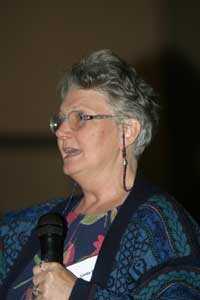Golden Alga (Prymnesium parvum) in Texas
Workshop Abstracts
Rapid Tests for the Detection of Prymnesium parvum and Its Toxins
 Linda
Medlin*, Gundula Ellers, Kerstin Toebe, and Katja Kerkmann
Linda
Medlin*, Gundula Ellers, Kerstin Toebe, and Katja Kerkmann
Alfred Wegener Institute, Am Handelshafen 12 D.-27570 Bremerhaven, Germany
Abstract.--Oligonucleotide probes or signature sequences are phylogenetic determinative tools in environmental microbiology. rRNA genes are so variable that they offer regions that are species or even strain specific. These regions can be targeted for the design of probes to recognize species or even strains. We present three platforms for the detection of species, in this case Prymnesium parvum using rRNA probes. DNA microarray technology provides a tool that allows the parallel analysis of large numbers of molecular probes. The application of such DNA-chips for the cultivation-independent analysis concerning the biodiversity of phytoplankton-samples would save a lot of time in comparison to other well-established technologies e.g. dot-blots. Therefore we are currently developing a DNA-microarray-based method for the high throughput analysis of phytoplankton-communities. DNA-chips have been developed by spotting probes targeting the 18S-rDNA of six different phytoplankton classes. In preliminary experiments it was possible to detect specific and some unspecific hybridization-signals with PCR-products from nine different species hybridized to the DNA-Chips. Species level probes were used for the development of an early warning system for use with a hand-held DNA microchip reader with electrochemical detection with sandwich hybridization. Results from field trials show excellent correlation with cell numbers and with total RNA content from laboratory cultures. Shelf life and stability of the microchips has been tested through 5 months and offer our prototype excellent possibilities for marketing. The hand-held device is ca. 25 Euros and the disposable microchip is 2.50 Euros. Theoretically, up to 400 probes can be spotted on the chip with the specificity of the chip determined by the signal probe. It would be conceivable to custom design the chip to cater to local HAB needs. Using standard FISH hybridization on filters we employed the ChemScan solid phase cytometry to scan filters within 30 seconds and record all positive signals. The microscope driven computer software enables each positive signal to be retrieved and validated for authenticity. Haemolytic substances produced by ichthyotoxic algae are unknown in molecular structure or specific mechanism of toxicity. Detection and quantification of such substances is dependent on bioassays, using markers that are sensitive for haemolytic impairment and generation of a recordable response. The erythrocyte lysis assay (ELA) represents an advantageous bioassay in this respect, as the lytic response can be measured photometrically by the amount of released haemoglobin. This bioassay has been adapted to a microtiter plate platform for rapid analysis of haemolysis.
* Presenter at Golden Alga Workshop
Download
presentation  (PDF 3.7 MB). If
you are unable to access this document, please contact
us for an alternative format.
(PDF 3.7 MB). If
you are unable to access this document, please contact
us for an alternative format.